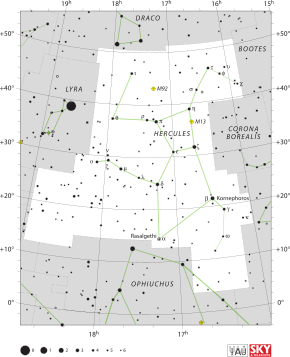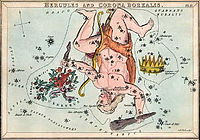Hercules (constellation)
| Constellation | |
 | |
| Abbreviation | Her |
|---|---|
| Genitive | Herculis |
| Pronunciation | /ˈhɜːrk[invalid input: 'jʉ']liːz/, genitive /ˈhɜːrk[invalid input: 'jʉ']l[invalid input: 'ɨ']s/ |
| Symbolism | Heracles |
| Right ascension | 17 |
| Declination | +30 |
| Quadrant | NQ3 |
| Area | 1225 sq. deg. (5th) |
| Main stars | 14, 22 |
| Bayer/Flamsteed stars | 106 |
| Stars with planets | 14 |
| Stars brighter than 3.00m | 2 |
| Stars within 10.00 pc (32.62 ly) | 9 |
| Brightest star | β Her (Kornephoros) (2.78m) |
| Messier objects | 2 |
| Meteor showers | Tau Herculids |
| Bordering constellations | Draco Boötes Corona Borealis Serpens Caput Ophiuchus Aquila Sagitta Vulpecula Lyra |
| Visible at latitudes between +90° and −50°. Best visible at 21:00 (9 p.m.) during the month of July. | |
Hercules is a constellation named after Hercules, the Roman mythological hero adapted from the Greek hero Heracles. Hercules was one of the 48 constellations listed by the 2nd century astronomer Ptolemy, and it remains one of the 88 modern constellations today. It is the fifth largest of the modern constellations.
Notable features
Stars
Hercules has no first magnitude stars.
Mu Herculis is 27.4 light years from Earth. The solar apex, i.e., the point on the sky which marks the direction that the Sun is moving in its orbit around the center of the Milky Way, is located within Hercules, close to Vega in neighboring Lyra.
Planetary systems
Eleven stars in Hercules are known to be orbited by extrasolar planets. These planets were discovered one in 1996, two in 2005, two in 2006, four in 2007, one in 2009, and one in 2010.
- 14 Herculis has one confirmed and one unconfirmed planet. The planet 14 Herculis b had the longest period (4.9 years) and widest orbit (2.8 AU) at the time of discovery. The planet 14 Herculis c orbits much further out with very low eccentricity.
- HD 149026 has a transiting hot Jupiter planet and is one of the most prominent and studied.
- HD 154345 has the planet HD 154345 b, a long period (9.095 years) and wide orbit (4.18 AU).
- HD 164922 has the first long period Saturian planet discovered. The mass is 0.36 MJ and semimajor axis of 2.11 AU.
- HD 147506 has the most massive transiting planet HAT-P-2b at the time of discovery. The mass is 8.65 MJ.
- HD 155358 has two planets around the lowest metallicity planet-harboring star (21% Sun). Both planets orbit in mild eccentricities.
- GSC 03089-00929 has a short transiting planet TrES-3. The period was 31 hours and undergoing orbital decay.
- Gliese 649 has a saturnian planet around the red dwarf star.
- HD 156668 has a 4.15 Earth mass planet, which is the second lightest planet detected by radial velocity.
Deep-sky objects
Hercules contains two of the most awesome globular clusters: M13, the brightest globular cluster in the northern hemisphere (containing 300,000 stars), and M92. It also contains the nearly spherical planetary nebula Abell 39. M13 lies between the stars η Her and ζ Her; it is dim, but may be detected by the non-aided eye on a very clear night.
Visualizations
Traditional

The traditional visualization imagines α Herculis as Hercules's head; its name, Ras Algethi, literally means "head of the kneeling one". Hercules's left hand then points toward Lyra from his shoulder (Delta Herculis), and Beta Herculis forms his other shoulder. His narrow waist is formed by Epsilon and Zeta Herculis. Finally, his left leg (with Theta as the knee and Iota the foot) is stepping on Draco's head, the dragon/snake who Hercules has vanquished and perpetually gloats over for eternities.
Keystone asterism


A common form found in modern star charts uses the quadrangle formed by π Her, η Her, ζ Her and ε Her (known as the "Keystone" asterism) as Hercules's torso.
H.A. Rey
H.A. Rey has suggested an alternative visualization in which the "Keystone" becomes Hercules's head. This quadrangle lies between two very bright stars: Vega in the constellation Lyra and α CrB (Gemma, or Alphecca) in the constellation Corona Borealis. The hero's right leg contains two bright stars of the third magnitude: α Her (Ras Algethi) and δ Her (Sarin). The latter is the right knee. The hero's left leg contains dimmer stars of the fourth magnitude which do not have Bayer designations but which do have Flamsteed numbers. The star β Her belongs to the hero's outstretched right hand, and is also called Kornephoros.
History
According to Gavin White, the Greek constellation of Hercules is a distorted version of the Babylonian constellation known as the "Standing Gods" (MUL.DINGIR.GUB.BA.MESH). White argues that this figure was, like the similarly named "Sitting Gods", depicted as a man with a serpent's body instead of legs (the serpent element now being represented on the Greek star map by the figure of Draco that Hercules crushes beneath his feet). He further argues that the original name of Hercules - the 'Kneeler' (see below) - is a conflation of the two Babylonian constellations of the Sitting and Standing Gods.[1]
The earliest Greek references to the constellation do not refer to it as Hercules. Aratus describes it as follows:
Right there in its [Draco's] orbit wheels a Phantom form, like to a man that strives at a task. That sign no man knows how to read clearly, nor what task he is bent, but men simply call him On His Knees [Ἐγγόνασιν "the Kneeler"].
Now that Phantom, that toils on his knees, seems to sit on bended knee, and from both his shoulders his hands are upraised and stretch, one this way, one that, a fathom's length. Over the middle of the head of the crooked Dragon, he has the tip of his right foot. Here too that Crown [Corona], which glorious Dionysus set to be memorial of the dead Ariadne, wheels beneath the back of the toil-spent Phantom. To the Phantom’s back the Crown is near, but by his head mark near at hand the head of Ophiuchus [...] Yonder, too, is the tiny Tortoise, which, while still beside his cradle, Hermes pierced for stings and bade it be called the Lyre [Lyra]: and he brought it into heaven and set it in front of the unknown Phantom. That Croucher on his Knees comes near the Lyre with his left knee, but the top of the Bird’s head wheels on the other side, and between the Bird’s head and the Phantom’s knee is enstarred the Lyre.
The story connecting Hercules with the constellation is recounted by Dionysius of Halicarnassus:
On his way back to Mycenae from Iberia having obtained the Cattle of Geryon as his tenth labour Heracles came to Liguria in North-Western Italy where he engaged in battle with two giants, Albion and Bergion or Dercynus. The opponents were strong; Hercules was in a difficult position so he prayed to his father Zeus for help. With the aegis of Zeus, Heracles won the battle. It was this kneeling position of Heracles when prayed to his father Zeus that gave the name "the Kneeler".[4] and Hyginus
Equivalents
In Chinese astronomy, the stars that correspond to Hercules are located in two areas: the Purple Forbidden enclosure (紫微垣, Zǐ Wēi Yuán) and the Heavenly Market enclosure (天市垣, Tiān Shì Yuán).
References
- ^ Babylonian Star-lore by Gavin White, Solaria Pubs, 2008, page 199ff
- ^ "Ἐγγόνασιν (ἐν γόνασιν), Arat. 66, 669, Gal. 9. 936, etc."[1] Henry George Liddell and Robert Scott. A Greek-English Lexicon. Oxford. Clarendon Press, 1940.[]
- ^ trans. Mair, A. W. & G. R. Loeb Classical Library Volume 129. London: William Heinemann, 1921.[2]
- ^ Dionysius of Halicarnassus, i. 41
- ^ Hyginus, Astronomica Part 1, 6. The kneeler: Poet. Astr. ii. 6
- H.A. Rey, The Stars — A New Way To See Them. Enlarged World-Wide Edition. Houghton Mifflin, Boston, 1997. ISBN 0-395-24830-2.
- Ian Ridpath and Wil Tirion (2007). Stars and Planets Guide, Collins, London. ISBN 978-0-00-725120-9. Princeton University Press, Princeton. ISBN 978-0-691-13556-4.
